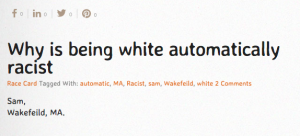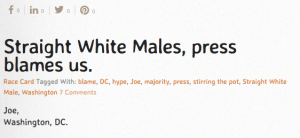Title: Race Card submission by Jameel Morrison
The Race Card Project is a website established by Michele Norris that provides a platform for people to express their experience of “race” by sharing a sentence of only 6 words. It contains a multitude of submissions that reflect the difficulties of discrimination, as well as strength and resilience; the comments both challenge and support the statements of others, creating a dynamic community.
One particular type of submission caught my attention. As fellow student Dora Dubber mentioned in class, there were a number of cards written in a seemingly defensive tone by individuals that identify as “white.” Such as this one:
Does “being white” really make one “automatically racist”? A little research unearthed the complex and controversial debate that is happening around this question and led me to the concept of “white privilege.” In a popular article about the subject, Peggy McIntosh describes white privilege as “an invisible package of unearned assets which [one] can count on cashing in each day, but about which [one is] ‘meant’ to remain oblivious.” She explains that all white people (in a Western context) are entitled to unspoken rights which enable them to achieve success with more ease than a person from a different ethnicity.
Since “white privilege” could only be solved through large scale institutional changes, several movements work towards its acknowledgement, as a first step, as demonstrated by campaigns such as the 2011 Un-Fair Campaign in Duluth (pictured here) or the 2014 school workshops about white privilege in Ontario.
Still, something seems to be missing from these movements, which is captured in Gina Crosley-Corcoran’s article, “Explaining White Privilege to a Broke White Person….” Having lived the beginning of her life in poverty, she explains her initial resistance to the term “white privilege,” finding that the whiteness of her skin did not ensure an easy rise to success. She goes on to explain that the issue does not simply concern ethnicity; privilege is based on many other titles that one is born into: citizenship, class, sexual orientation, sex, ability, gender…
These ascribed statuses, as we have discussed in our SOCI 100 class, play a huge role in the way a person fits into larger institutions of society, but each one does not ultimately determine their actual position or experience. Instead, it is important to study intersectionality, which refers to the way certain combinations of characteristics fit into power relations. For example, a lower class, straight heterosexual man’s experiences will be very different from those of an upper class lesbian woman.
As Crosley-Corcoran states: “Intersectionality allows us to examine these varying dimensions and degrees of discrimination while raising awareness of the results of multiple systems of oppression at work.”
This approach definitely does not simplify the idea of privilege, instead it acknowledges the fact that it encompasses much more than the colour of one’s skin. This complex and difficult issue is important to discuss, and I am curious to hear your thoughts.
Adèle Therias


